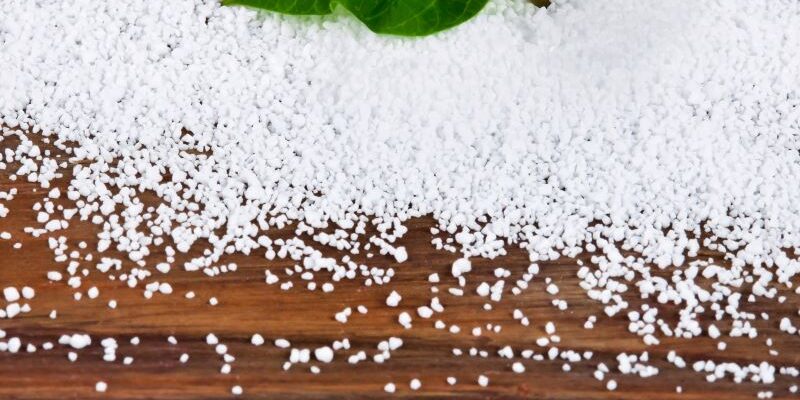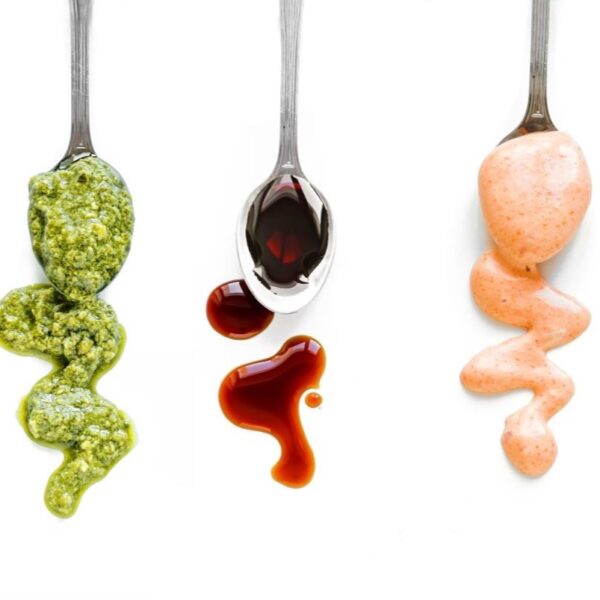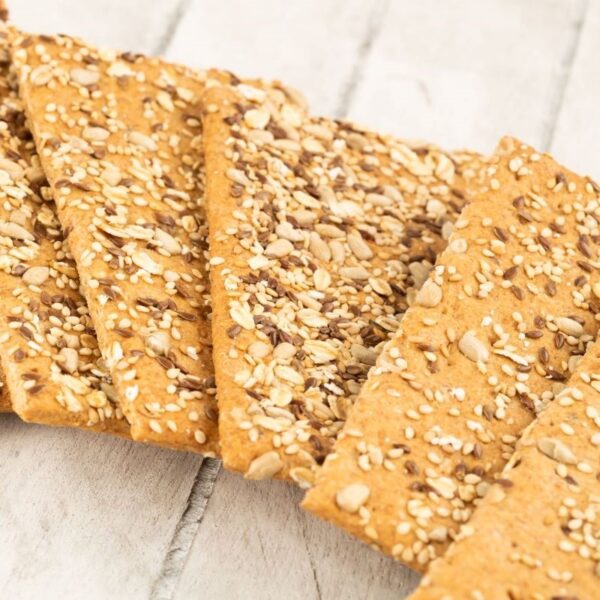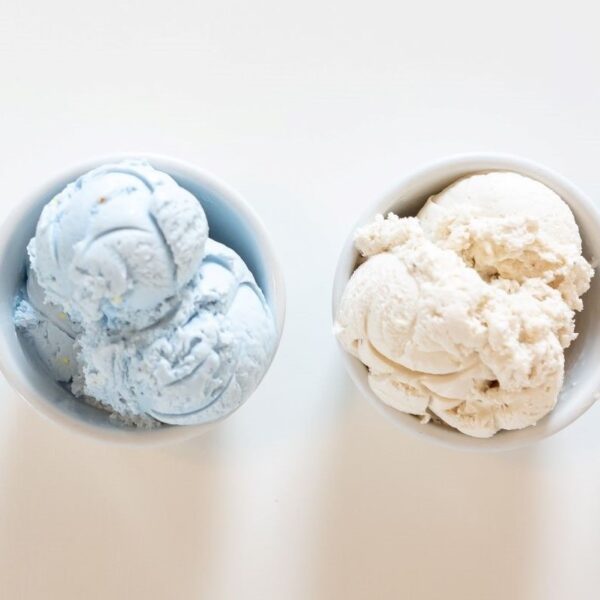Sorbitol, known by its IUPAC name as D-glucitol, is a sugar alcohol frequently used as a sweetening agent, moisture stabilizer, and texturizer in various food products. In this article, we’ll delve into the chemistry of sorbitol and the functional attributes that make it a popular choice in the food industry.
What is Sorbitol?
Sorbitol is a type of polyol, which means it is a sugar alcohol that is derived from the sugar glucose. It is a white, crystalline powder that is soluble in water. Sorbitol is often used as a sugar substitute for individuals with diabetes or those following a low-carbohydrate diet. It provides sweetness without causing a significant increase in blood sugar levels. Sorbitol is also commonly used as a bulking agent in various food products, helping to add volume and texture. It is considered safe for consumption by regulatory authorities when used in moderation.
Source: Wikipedia
Sorbitol is a six-carbon sugar alcohol with the molecular formula C6H14O6. It is derived from glucose through a process called reduction, where one of the aldehyde groups in glucose is converted to a hydroxyl group. This reduction reaction is catalyzed by an enzyme called aldose reductase. Sorbitol is an isomer of mannitol, another sugar alcohol; the two differ only in the orientation of the hydroxyl group on carbon 2.
How is Sorbitol Produced?
Sorbitol can be produced naturally, via fermentation, and also synthetically. Here’s a breakdown of the different methods of production:
Natural Sources
Sorbitol is found naturally in blackberries, raspberries, strawberries, and other fruits such as apples, apricots, avocados, cherries, peaches, and plums.
Fermentative Production
Microbial fermentation is another method used for sorbitol production. Certain strains of bacteria, such as Zymomonas mobilis and Escherichia coli, can ferment glucose into sorbitol. This process involves genetically modified microorganisms efficiently metabolizing glucose to produce sorbitol as a metabolic byproduct. Synthesis of sorbitol takes place by catalysis of glucose via NADP-dependent sorbitol-6-phosphate dehydrogenase (S₆PDH).
In genetically engineered Lactobacillus casei strain expressing a sorbitol-6-phosphate dehydrogenase gene within the lactose operon, the L-lactate dehydrogenase gene inactivation led to increased sorbitol production [1].
Synthetic Production
Chemical synthesis involves the conversion of glucose, typically derived from corn or wheat, into sorbitol using chemical reactions. The process requires hydrogenation, where glucose is hydrogenated in the presence of a catalyst, such as nickel or platinum, under specific temperature and pressure conditions. This reaction converts glucose into sorbitol [2].
Use and Applications of Sorbitol in the Food Industry
Sorbitol serves as a multifunctional ingredient in the food industry. As a sweetener, it provides approximately 60% of the sweetness of sucrose, making it a preferred choice in sugar-free and reduced-calorie products, especially for those tailored for people with diabetes. Beyond its sweetening properties, sorbitol acts as a humectant, attracting and retaining moisture, which helps maintain freshness and extend the shelf life of food products. Its hygroscopic nature also lends a smooth texture by preventing sugar crystallization in foods, especially candies and syrups. Furthermore, as a bulking agent, sorbitol contributes volume without excessive sweetness, and as a cryoprotectant, it ensures the palatability of frozen foods by preventing the formation of large ice crystals. These versatile characteristics make sorbitol a staple in various food applications, from confectioneries to baked goods.
Here’s a breakdown of some of the more common functions of sorbitol in food products:
| Function | Role |
| Bulking Agent | Adds volume to food products without significantly adding calories |
| Emulsifier | Helps to stabilize mixtures of two immiscible liquids, such as oil and water |
| Stabilizer | Helps to prevent unwanted changes in the texture or consistency of food products over time |
| Thickener & Texturizer | Helps to thicken the consistency of food products |
| Humectant | Helps retain moisture in food products |
Product Examples
These are some of the most common products sorbitol is found in:
| Type | Examples |
| Bakery | Cake, Pastry, Cookies, Bread |
| Confectionery | ChewingGgums, Soft Chews, Gummy Bears, Crystal Candies |
| Dairy | Yogurt, Ice Cream |
| Beverages | Juices, Soft Drinks |
| Convenience | Jams, Jellies, Cereals, Fruit Preserves |
Properties of Sorbitol
| Molecular Weight | 101 |
| Melting Point | 101℃ |
| Heat of Solution | -111 J/g |
| Physical Form | Powder, Crystals (Granules) & Syrup |
| Solubility (25℃) | 235 g/100g Water |
| Viscosity (1% w/v, 25℃) | 5.0 cP |
| Calorific Value | 2.6 Cal/g |
| Relative Sweetness w.r.t Sucrose | 50-60% |
| Glycemic Index | ~9 |
| Shelf Life | 24-36 months |
| GMO Status | GMO/Non-GMO |
| Claims *Subject to product claims | Kosher, Halal, Dairy-free, Sugar-free, Non-cariogenicPlant based*, Organic*, Non-GMO*, Natural*, Allergen-free* etc. |
| Storage Requirements | Cool, dry, dark place < 40℃) |
| Specific Rotation | Optically inactive |
Typical Formulations
Candy
Here is an example formulation table of clear candy with sorbitol with the weight composition of the ingredients.
| Ingredient | Composition |
| Sorbitol powder | 300 g |
| Water | 15 g |
| Mixed sesame seeds | – |
| Natural lemon essence | 2 g |
| Menthol | 0.3 g |
Gradual cooling of molten sorbitol in a specific temperature range for a particular time, under a certain cooling rate condition under strict temperature control, has helped obtain clear hard candy. No unevenness or roughness on the surface was observed.
Source: Google Patents
Chewing Gum
Here is an example formulation table of chewing gum with sorbitol with the % composition of the ingredients.
| Ingredient | % Composition |
| Gum base | 20.7 |
| Sugar | 51.5 |
| Sorbitol | 2.7 |
| Corn syrup | 13.2 |
| Dextrose monohydrate | 10.1 |
| Glycerin | 1.2 |
| Spearmint flavor | 0.6 |
A possible explanation for using molten sorbitol is that it is modified from a crystalline state to a more amorphous state, which may allow it to act as a gum plasticizer or softening agent.
Source: Google Patents
Mango Squash
Here is an example formulation table of synthetic mango squash with sorbitol with the weight composition of the ingredients.
| Ingredient | Composition |
| Guar gum | 8 g |
| Sorbitol | 700 ml |
| Citric acid | 3.75 g |
| Sodium citrate | 1 g |
| Sucrose acetate iso-butyrate | 1 ml |
| Mango flavor | 1 ml |
| Mango color | 0.25 g |
| Sodium benzoate | 1 g |
Sorbitol was used here as the sole sweetener in the squashes for consumption of diabetic patients.
Source: Aup.edu
Sorbitol Formulation Considerations
Stability
Sorbitol is generally stable concerning heat, light, and oxidation. D-Sorbitol showed a degradation starting at 200°C [3].
Physical Forms
Sorbitol exists in two forms: a crystalline and a liquid form. The crystalline structure is a white, odorless powder with a sweet taste. It has a melting point of around 95-97°C. The liquid form, or sorbitol solution, is a viscous, colorless liquid with a sweet taste. It is commonly used in liquid medications, syrups, and oral care products.
Sensory Properties
Sensory Profile
| Physical Form | Liquid, powder, crystals |
| Color | White |
| Taste | Sweet (towards sucrose) |
| Odor | Odorless |
Sweetness Profile
| Taste Profile | Sweet taste with a smooth mouthfeel |
| Aftertaste | No aftertaste |
| Off-taste | No off-taste |
| Taste & Appearance | Sweetness appears quickly and has a shorter persistence |
Use as a Sugar Substitute
Sorbitol is a sugar alcohol commonly used as a sugar substitute.
Benefits of usage of sorbitol as a sugar substitute
- Sorbitol provides sweetness and bulk, unlike the artificial non-caloric sweeteners viz. acesulfame K, neotame, aspartame, and saccharin.
- It is an excellent humectant and texturizing agent.
- It does not contribute to dental caries.
- It may be helpful to people with diabetes.
The following table comparing the properties of sorbitol with other sugar alcohols can play a pivotal role in understanding the suitable sugar substitute in any formulation.
| Sugar alcohol | Calorific value (kcal/g) | Relative Sweetness (to Sucrose) | Glycemic index |
| Maltitol | 2.1 Cal/g | 80-90 % | ~35 |
| Erythritol | 0.2 Cal/g | 60-70 % | ~0 |
| Xylitol | 2.4 Cal/g | 80-100 % | ~13 |
| Sorbitol | 2.6 Cal/g | 50-60 % | ~9 |
| Sucrose | 4.0 Cal/g | 100% | ~65 |
A detailed comparison of all sugar alcohols can be seen here.
Limitations of usage of sorbitol as a sugar substitute
- High caloric value
- Lower relative sweetness with sucrose compared to xylitol and maltitol
Metabolism, Absorption & Excretion
| Absorption | Sorbitol is slowly absorbed by passive diffusion in the small intestine. After oral administration, it increases osmotic pressure in the bowel by drawing in water and is thus an osmotic laxative [4]. |
| Metabolism | – NAD-linked sorbitol-6-phosphate dehydrogenase (EC 1.1.1.140) converts sorbitol 6-phosphate to fructose 6-phosphate [5]. – Bacterial sorbitol fermentation in the large bowel is associated with increased flatulence and abdominal cramping. – The digestibility of the other nutrients is also reduced due to the osmotic load caused by the polyols in the small intestine [6]. – Acute oral administration of sorbitol does not affect glucose homeostasis, which is only slightly disturbed by a large intravenous load of sorbitol [7]. |
| Excretion | Sorbitol will either be excreted in the urine by the kidneys or metabolized to carbon dioxide and dextrose [4]. |
Effect on Properties of Food Products
As a food additive, Sorbitol exerts some effects on the food products it adds.
Functional Properties
| Freezing Point Depression | In terms of its effect on freezing point, sorbitol can lower the freezing point of a solution. This is because sorbitol molecules disrupt the formation of ice crystals, preventing the solution from freezing at its average temperature. Sorbitol exhibited a more significant freezing point depression than reducing sugars [8]. |
| Shelf-Life Extension | – Sorbitol can be used as an osmolyte to extend the shelf life of perishable goods. – The postharvest quality of ivy gourd was effectively extended by mannitol and sorbitol for up to 10 days without significantly affecting their phytochemical and physiological attributes [9]. |
Safety and Regulatory Considerations
| FDA Information | Sorbitol is generally recognized as safe (GRAS) by the U.S. Food and Drug Administration (FDA) when used per good manufacturing practices [10]. |
| EU Information | In the European Union, sorbitol is regulated as a food additive under the European Food Safety Authority (EFSA). It is assigned the E number E420 and is approved for use as a sweetener, humectant, and stabilizer in various food and beverage products. |
Health Effects of Sorbitol
Unlike other simple sugars, sorbitol is metabolized slowly in the human body, leading to a more gradual rise in blood sugar levels. This makes it a preferable alternative to sugar for individuals with diabetes or those monitoring their blood sugar levels.
Polyols (sorbitol, mannitol, xylitol, maltol, maltitol, and erythritol) have known laxative properties. However, quantities more significant than 50 g daily were laxative. A total of 25 g daily in two doses caused no laxative effect. This effect was presumably due to the relatively slow rate at which sorbitol was absorbed from the small bowel [14].
Sorbitol can cause gastrointestinal symptoms (gas, urgency, bloating, abdominal cramps) dose-dependently [15]. Sorbitol is frequently overlooked as a potential cause of diarrhea [16].
Identification Numbers
| IUPAC Name | (2R,3R,4R,5S)-hexane-1,2,3,4,5,6-hexol |
| CAS Number | 50-70-4 |
| EC Number | 200-061-5 |
| INS No. (Food Additive) | INS 420 |
| E Number (Food Additive) | E 420 |
Acceptable Limits or Maximum Usage
The FDA prescribes the maximum level of usage of sorbitol for the following categories of foods [10].
| Category | Usage |
| Hard candy & cough drops | 99% |
| Chewing gum | 75% |
| Soft candy | 98% |
| Non-standardized jams and jellies | 30% |
| Baked goods & baking mixes | 30% |
| Frozen dairy desserts | 17% |
| All other foods | 12% |
As per the FDA, food whose reasonably foreseeable consumption may result in a daily ingestion of 50 grams of sorbitol shall bear the statement: “Excess consumption may have a laxative effect.” [10].
Fun Facts About Sorbitol
- Sorbitol is one of the compounds discovered on Mars! In 2015, the Curiosity Rover detected the presence of various organic compounds on the red planet, and sorbitol was among them.
- Unlike regular sugar, sorbitol doesn’t lead to cavities. This quality makes it a popular ingredient in sugar-free gum and toothpaste. Bacteria in the mouth can’t readily convert sorbitol into acid-producing decay catalysts as they do with sucrose.
- Besides its extensive use in the food industry, sorbitol is also used in cosmetic products like lotions and creams due to its excellent moisturizing properties.
- Sorbitol was once used as a fuel in solid rocket propellants. When combined with a powerful oxidizer, it can rapidly combust.
- In medical settings, sorbitol is sometimes used as a laxative. It works by drawing water into the large intestine stimulating bowel movements.
- Sorbitol was first discovered by a French chemist named Boussingault in 1872. He isolated it from the fresh juice of mountain ash berries, which is why its name is derived from the genus of these trees, Sorbus.
Additional Resources
- FEMS Microbiology Letters – Sorbitol utilization by lactic acid bacteria: a review
- United States Patent 4507511A – Composition for the treatment of constipation
- ResearchGate – TGA thermal decomposition profile of D-Sorbitol, CE-CE, T-SI150, SI200, and GLT powders
- ScienceDirect – Food Chemistry, Fourth Edition
- ScienceDirect – Food Biochemistry and Food Processing, Second Edition
- PubMed – Intestinal absorption of sorbitol and effects of its acute administration on glucose homeostasis in normal rats
- Cambridge Core – Intestinal absorption of sorbitol and effects of its acute administration on glucose homeostasis in normal rats
- Journal of Dairy Science – Effect of sorbitol and lactose on the rheological properties and water holding capacity of concentrated skim milk
- ScienceDirect – Food Hydrocolloids, Volume 77
- FDA CFR – Code of Federal Regulations Title 21, Part 184.1835 Sorbitol










